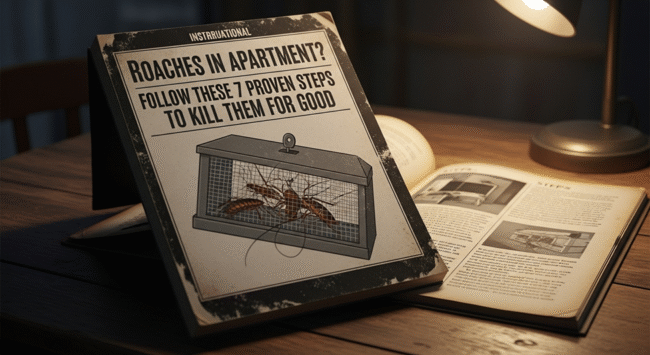
Seeing a cockroach scuttle across your kitchen floor can send a shiver down your spine. That moment of panic and disgust is completely understandable. Roaches aren’t just creepy; they’re unsanitary pests that can carry harmful bacteria like E. coli and Salmonella, trigger allergies, and even worsen asthma—especially in children.
But don’t despair! You don’t have to live with these unwelcome guests. This detailed, step-by-step action plan will show you exactly how to get rid of roaches in your apartment and prevent them from coming back.
Step 1: Identify the Type of Roaches
Before you can effectively fight roaches, you need to know your enemy. Different species respond better to specific treatment strategies.
- German Cockroaches: Most common in apartments. Light brown with two dark stripes. Found in kitchens and bathrooms. Reproduce quickly.
- American Cockroaches: Large reddish-brown roaches (up to 2 inches). Often in basements, drains, or migrating upward into homes.
- Brown-Banded Cockroaches: Small with two light bands. Found in warm, dry areas—walls, furniture, or picture frames.
Why it matters: Knowing the species helps you choose the most effective bait and strategy. German roaches, for example, often need a combination of gel baits and professional-grade treatment.
Tip: Look for droppings (like ground pepper), egg cases, and hiding spots like behind the fridge, under sinks, or in wall crevices.
Step 2: Find and Seal Entry Points
Roaches sneak in through the tiniest openings—especially in apartment buildings where they migrate between units.
Common entry points:
- Gaps around plumbing
- Cracks in walls/floors
- Spaces around doors and windows
- Electrical outlets and bathroom/kitchen vents
Solution: Use caulk to seal cracks. Install door sweeps. Cover vents with mesh. In multi-unit buildings, sealing is essential to stop incoming roaches from neighboring apartments.
Step 3: Declutter and Deep Clean
Roaches love hiding in clutter and feeding on crumbs. A dirty, cluttered home = a roach paradise.
Focus your cleaning on:
- Under/behind stove and fridge
- Inside cabinets and pantries
- Under sinks
- Pet feeding areas
Action Plan:
- Vacuum baseboards, corners, and hidden spaces
- Sanitize surfaces nightly
- Never leave pet food or trash out overnight
Tip: Take the trash out daily and always wipe counters before bed.
Step 4: Starve Them
Roaches can live weeks without food but die in days without water.
- Store food in airtight containers — don’t rely on cardboard or thin plastic bags
- Wash dishes immediately — never leave dirty ones overnight
- Fix leaks under sinks or toilets
- Wipe up spills and moisture right away
Step 5: Attack with Baits and Traps
Once your home is clean and sealed, you’re ready for attack. Gel baits like Advion or Combat Max are excellent—they’re slow-acting, letting the poison spread to the colony.
Where to apply baits:
- Behind fridge/stove
- Inside cabinets (away from food surfaces)
- Along baseboards and plumbing
- Near trash cans and under sinks
Sticky traps help track progress. They’re great for monitoring hot spots and seeing if your plan is working.
Step 6: Use Sprays (Sparingly)
Sprays can be effective for instant kills but shouldn’t replace baiting.
- Use sprays like Raid only when you see a live roach
- Try natural methods like:
- Boric acid + sugar mix
- Diatomaceous Earth (DE) — food-grade version only!
Caution: Overuse of sprays can scatter roaches or make baiting ineffective. Use only in emergencies or for visible roaches.
Step 7: Talk to Your Landlord or Neighbors
Roaches travel. Even if you clean your unit perfectly, your neighbor’s infestation can become yours.
- Inform your landlord/property manager — they may be required to arrange pest control
- Speak to your neighbors — a coordinated effort = better results
- Call pest control if things escalate. Professionals can use residual sprays and growth regulators for long-term solutions.
Bonus: Keep Roaches from Coming Back
- Monthly deep clean kitchen + bathroom
- Dry everything — no leaking sinks or damp areas
- Check used items before bringing them home (especially cardboard boxes and furniture)
- Use perimeter insecticide around baseboards or entry points if needed
Need a full roach prevention plan for your entire house, including outdoor perimeters and seasonal defense tips? Cockroach Control & Prevention – Your Definitive Guide to a Roach-Free Home
Conclusion
Roaches are relentless—but so are you. By following these 7 proven steps consistently, you can eliminate these pests and finally reclaim your peace of mind. Whether you’re in an apartment battling German roaches or in a house trying to prevent future invasions—action, not panic, is the key.
FAQ Section
Q: How long does it take to kill all roaches? A: It depends on the severity of the infestation and the species, but typically you’ll start seeing a significant reduction in a few weeks. Complete eradication can take anywhere from 2 to 6 months, especially for German cockroaches due to their rapid breeding cycle. Persistence is key.
Q: Is it safe to use boric acid with pets? A: Boric acid should be used with extreme caution around pets and children. While it has low toxicity to humans and pets, ingestion can cause stomach upset. Apply it in very thin layers in inaccessible areas, like behind appliances or deep in cracks, or consider professional treatment if you have curious pets or young children.
Q: What attracts roaches in clean apartments? A: Even the cleanest apartments can get roaches. They might be attracted by:
1. Water sources: Leaky pipes, condensation, or even pet water bowls.
2. Neighboring units: If a neighbor has an infestation, roaches will migrate through shared walls, pipes, and vents.
3. Food crumbs: Even tiny crumbs under appliances or in cabinets can sustain them.
4. Warmth and shelter: Dark, undisturbed areas like wall voids, electronics, or cluttered storage areas.
